Brian Branciforte

I’m a big advocate of having a work team. I enjoy feeling
connected through a common purpose and having others involved with similar
goals. My team is within an office, within a division, within an agency, and so
on and so on. This hierarchical organization is a product of where I work and
has benefits to offer. The structure has a clear delineation of authority,
roles and process, which provides a sense of order and security for all
employees. The need of belonging to a like-minded group traces back to our
ancestors and the concept referred to as tribalism. It’s not just at work of
course. We identify ourselves as members of families, neighborhoods, social
organizations, a geography and sports teams, as a few examples.
There’s a negative byproduct that can occur because of work
unit organization as well. We often refer to it as creating silos or
stovepiping, and it’s when a unit operates in isolation, competition or without
regard to others. In conservation, you many recognize different general silos being
field biologists, office administrators, researchers, managers, accounting,
etc. Next time you are in a large meeting, look around and see if you can
identify any potential tribes. Within any organization there is a balance to be
found of creating the right structure to divvy the work, but also to instill
practices that will prevent silos from forming.
This is an example of the importance of Florida’s Wildlife Legacy Initiative. We strive to combat the silo effect
through the practice of collaborate conservation and engagement through multi-faceted
partnerships. All stakeholders working in conservation can find common ground
and purpose in the field toward the end goal of conserving wildlife and
habitats. As conservation wades through tough issues, we must remember the
benefits of working together rather than through our silos.
|
Back to top
Andrea Alden
Florida’s
Wildlife Legacy Initiative sets goals and
measurable objectives for implementing the State Wildlife Action Plan. The Implementation
Goals direct the use of FWC resources, including State
Wildlife Grants, and provide opportunities for
partners to align conservation priorities to conserve Florida's fish and
wildlife. Florida’s Wildlife Legacy Initiative revises the State Wildlife
Action Plan along with the Implementation Goals approximately every five years.
The most recent update to Implementation Goals occurred in early 2018 and is
now included in the Program Guidelines document referenced in Grant Rule
68-1.003.
Regular updates
to the State Wildlife Action Plan and Implementation Goals allow for
integration of new information, evaluation of priorities and opportunity to
engage with partners. The following Implementation Goals
and objectives will be achieved through five State Wildlife Grant funding
cycles, with the first set of projects beginning in July, 2019. Implementation Goals target
high-priority needs that have a significant impact on the state’s Species of Greatest Conservation Need.
For more information regarding our Implementation Goals, please contact
your local Wildlife Legacy Biologist.
Implementation Goals
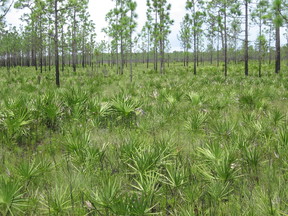 TERRESTRIAL HABITAT INTEGRITY
Goal: Improve and maintain the quality of upland habitats for the benefit of Species of Greatest Conservation Need.
Objective: Apply fire-related management on at least 150,000 acres of priority upland habitat.
Priority habitats: Sandhill, scrub, pine flatwoods, dry prairie, pine rockland and associated wetlands.
|
 AQUATIC HABITAT RESILIENCY
Goal: Improve aquatic ecosystem habitat quality and connectivity for the benefit of Species of Greatest Conservation Need.
Objective: Improve physical habitats in aquatic systems by restoring and enhancing at least 3,000 feet of stream habitat and 1,000 acres of wetlands utilized by Species of Greatest Conservation Need.
Priority habitats: Forested and non-forested wetlands, rivers and streams.
|
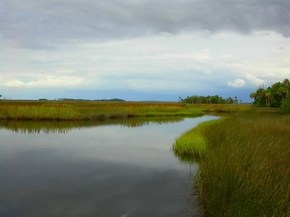 MARINE & ESTUARINE HABITAT ENHANCEMENT
Goal: Improve marine and estuarine ecosystem habitat quality for the benefit of Species of Greatest Conservation Need.
Objective 1: Complete at least four acres of high priority coastal habitat improvement by creating or restoring habitat in each of oyster reef, mangrove, salt marsh and upland buffer.
Objective 2: Increase coral cover by at least 25 percent on no fewer than 60 reefs through the repeated outplanting of no less than 60,000 colonies of reef-building elkhorn, brain, boulder and star corals, and monitor outplant success for at least a five-year period.
Priority habitats: Saltmarsh, mangrove, oyster reef, seagrass, coral reef.
|
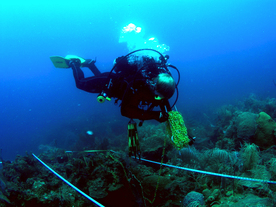 RESEARCH & MONITORING
Goal: Produce research and monitoring results that will improve management of Species of Greatest Conservation Need and their habitats.
Objective 1: Acquire information necessary to improve the management of at least five Species of Greatest Conservation Need or their habitats.
Objective 2: Address climate change vulnerability of at least two Species of Greatest Conservation Need by identifying or implementing adaptation strategies.
Objective 3: Maintain and use species and habitat status assessment tools to evaluate the effectiveness of conservation actions.
|
Back to Top
Kevin Kemp
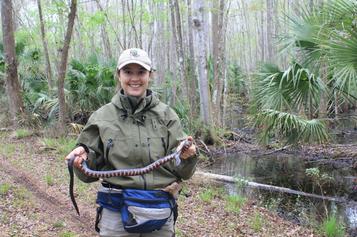
Florida’s Wildlife Legacy Initiative has a new team member! Anna
Deyle was recently hired as the new Wildlife
Legacy Biologist in the Northeast Region. Based in the FWC’s Ocala
office, Anna is the new lead for the Terrestrial Goal Team, which focuses on
improving and maintaining upland habitats for the benefit of Species of
Greatest Conservation Need.
While new to FWLI, Anna is not new to the FWC, having worked for
the agency since 2013. In her previous role she served as the Northeast Assistant Species Conservation Biologist,
working with various Species of Greatest Conservation Need and their habitats
throughout the FWC’s Northeast Region.
Anna received her master’s
degree in biology with a concentration in ecology and evolution from the
University of South Florida, where she studied the population genetics of
two-toed amphiuma and greater siren salamanders in the freshwater wetlands of
Florida. Prior to that, she received her B.S. in environmental biology from
Beloit College.
In addition to her duties
as the Terrestrial Goal Team lead, Anna is also conducting a study on coastal
dunes crowned snakes. Anna is hoping to identify where this species occurs on
public lands in three counties on the Atlantic coast. Anna can be reached at Anna.Deyle@MyFWC.com
|
Back to Top
Allie McCue
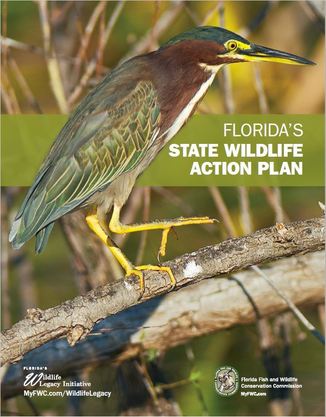
In December
2014, I was hired as the new State Wildlife Action Plan Coordinator. Joining
Florida’s Wildlife Legacy Initiative, I knew that my primary task would be leading
our team and the Florida Fish and Wildlife Conservation Commission through the
second Action Plan revision. Little did I know that FWLI already had been
discussing and preparing for the revision even prior to me coming onboard. Also,
what I quickly learned was that the expectation was a complete overhaul of the
nearly 700-page document, which is far from the “revision” challenge I thought
we were facing. Nearly four years have passed since then, and we can finally
say with confidence the finish line is in sight. The 2018 version of the Action
Plan will be submitted to the U.S. Fish and Wildlife Service for approval in
the coming weeks!
The road to
get to this point was filled with meandering dead ends, rough terrain and a lot
of stopping and asking for directions. But through this less than perfect
process, the Action Plan took shape and ultimately became the best version yet.
This success is not only due to the hard work and dedication that FWLI staff
have contributed, but also to the numerous partners and subject matter experts
who tediously reviewed draft after draft.
The review
process was long and labor intensive. Each chapter draft was distributed
multiple times for review to FWLI staff, a small revision team, targeted
experts, all FWC staff and finally externally to partners and the public. Each
of these steps taking weeks if not months to provide ample time for a thorough
review of each document, and for the comments and edits to be discussed and
addressed.
Now that
final review process is over, and more than 600 individual comments have been incorporated
just from the public review, it becomes even more obvious what an incredible
team effort this has been. From the initial brainstorming phase, to working on
draft 1 through 20, the final product is a true reflection of the collaboration
and coordination that it took to get here.
We are
excited to enter the next phase and looking forward to continued coordination
and partnership development as we work together to implement the Action Plan
for the benefit of Florida’s Species of Greatest Conservation Need. A
notification will be sent when the Action Plan is available for download,
pending U.S. Fish and Wildlife Service approval.
For more information on Florida’s State Wildlife
Action Plan contact: Allie McCue, Allie.McCue@MyFWC.com
|
Back to Top
Andrea Alden
Florida’s Wildlife Legacy Initiative is excited to announce
projects recently selected to receive State Wildlife Grant
funding! During the past year, FWLI Goal Teams have worked with numerous
external and internal partners in developing project scopes of work, drafting
and posting announcements, and reviewing submissions. The proposed awards,
listed below, total $1.62 million and will help FWLI achieve its 2012 to 2018 goals by
implementing the State Wildlife Action Plan. All
projects began this summer.
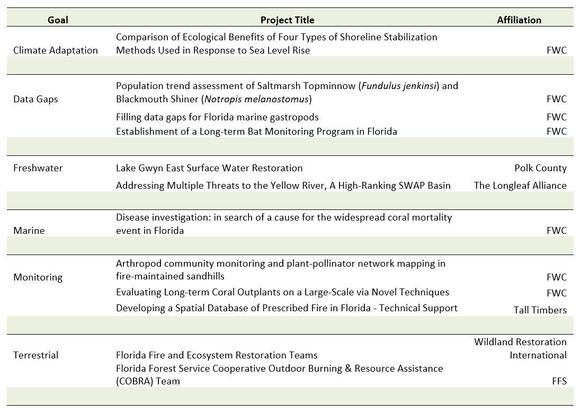 FWLI thanks the FWC staff from many sections and the external partners without whom the latest State Wildlife Grants cycle would not have been successful. FWLI also thanks the U.S. Fish and Wildlife Service’s Florida field offices and the Region 4 office in Atlanta for assistance and providing the funding that makes these projects possible.
If you are interested in State Wildlife Grant funding, contact Florida’s Wildlife Legacy Initiative.
Back to Top
Thomas Kuhn
Since 2012, Florida’s Wildlife Legacy Initiative has been working through its Freshwater Goal to improve freshwater habitats and overall water conditions to benefit Florida’s aquatic wildlife. Partnerships with other agencies and nongovernmental organizations have been critical to meeting the objectives of this goal. These objectives include:
- Enhancing aquatic conditions and restoring 90 acres of wetlands.
- Assessing threats and identifying key sites in need of restoration on one river.
- Stabilizing at least 200 feet of stream bank to reduce erosion and provide desirable habitat for Species of Greatest Conservation Need.
FWLI is pleased to report the freshwater objectives for 2012-2018 will be met, once currently ongoing projects are completed. These objectives were challenging, but projects have been conducted all over the state to accomplish them. One central Florida project restored 56 acres of dried lake bottom in the western half of Lake Gwyn in Polk County into wetland habitat supporting a wide variety of species, including the endangered snail kite. This summer, another Lake Gwyn project was launched to convert the eastern 50 acres of dried lake bottom into wetland habitat as well. In northwest Florida, through the efforts of the Longleaf Alliance’s Wetland Ecosystem Support Team, wetlands and river corridors that are critical habitat for bog frogs, flatwood salamanders and other Species of Greatest Conservation Need are being restored by prescribed fire and invasive plant removal.
Yet another project seeks to better understand the threats facing two of Florida’s peninsular rivers, the Peace and Withlacoochee. Threat assessments were conducted, providing information that is guiding future restoration efforts in those systems. In north Florida too, along the Chipola River, 200 feet of particularly degraded shoreline were restored and an additional 2.3 miles naturally restored themselves once cattle fencing was installed, all of which conserved and enhanced vital spawning grounds for shoal bass. In addition to these efforts, other projects studied stream habitats throughout Florida with side-scan sonar systems, calibrated the Field Assessment of Erosion Potential (Bank Erosion Hazzard Index) for use in northwest Florida and are currently examining the extent to which the connectivity of Florida’s waterways has been compromised. Much has been accomplished over the last six years. A new freshwater goal looks ahead through 2025, challenging the FWLI and its partners to accomplish even more in the future.
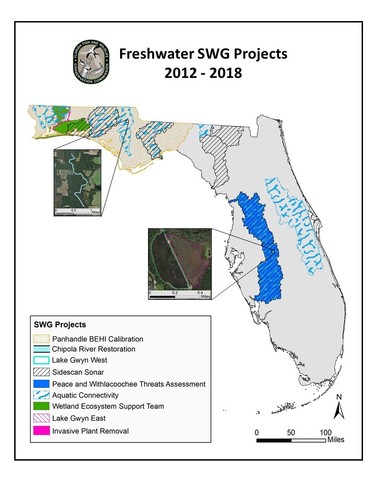 |
Back to Top
We don't always take enough time to celebrate hard work and amazing
accomplishments. Florida’s Wildlife Legacy Initiative is recognizing a few of the
following principal investigators who finished their State Wildlife
Grant-funded projects since the last newsletter publication. These projects demonstrate the
wide variety of conservation efforts taking place in Florida – from research
and on-the-ground restoration to management, mapping and monitoring. For more
information on the following projects, please contact Andrea.Alden@MyFWC.com or Robyn.McDole@MyFWC.com
Congratulations to all on work well done!
Living Shorelines: Naturally Adapting to Climate Change
Principal Investigators: Annie Roddenberry, Florida Fish and Wildlife Conservation Commission and Chad Truxall, Marine Discovery Center
While seawalls and other shoreline armoring methods provide important protection from flooding and erosion, they can also fragment wildlife habitat. Living shorelines offer an alternative way to protect coastlines while creating habitat for animals such as the 100 plus Species of Greatest Conservation Need that occur in the vibrant salt marsh and bivalve reef habitats where this project was based. As dynamic systems, living shorelines can even offer additional protection from sea level rise by adapting to keep pace with rising seas. For instance, recycled oyster shells can be used to construct living shorelines that provide oyster reef habitat, which can naturally build up sediment as sea levels rise over time.
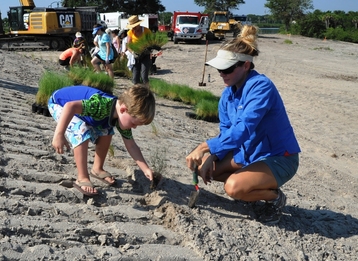
Left: Volunteers installing native plants at Mosquito Lagoon Marine Enhancement Center near the shoreline in New Smyrna Beach, FL.
Recycled oyster shells were a key material
used in this project, which
involved construction of a .68 acre living shoreline made with recycled shells
at Mosquito Lagoon Marine Enhancement Center (MLMEC) in New Smyrna Beach,
Florida. The project addressed the Climate
Adaptation Objective of
the State Wildlife Action Plan Monitoring and Adaptation Goal (2012-2018) through
construction of the MLMEC shoreline as well as an additional living shoreline
on nearby “Discovery Island,” intended to serve as an outreach and educational destination
for visitors and to enhance a demonstration site already present at MLMEC. Outreach was crucial not only to the
objectives of this project but also to its success – the project team relied
heavily on the efforts of volunteers for construction of both shorelines. Sediment buildup has occurred in areas in
need of stabilization since the project was completed, and visitors of all ages
can enjoy touring the site and enjoy viewing the diverse array of wildlife
making use of the newly restored habitat.
|
Fire line Preparation and Fuel Reduction at Kissimmee Prairie Preserve State Park
Principal Investigator: Jennifer Benson-Hughes, Florida Department of Environmental Protection
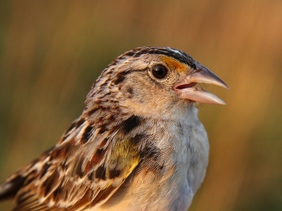 This project contributed to Florida’s State
Wildlife Action Plan 2012-2018 Terrestrial Implementation Goal to, “increase
the use of fire management to improve upland habitat conservation to benefit
Florida’s Species of Greatest Conservation Need (SGCN).”
Right: Florida Grasshopper Sparrow
It allowed Kissimmee
Prairie Preserve State Park to hire a staff member to assist with maintaining
fire line breaks and conducting prescribed burns in dry prairie habitat. Dry
prairie supports 50 SGCN species, including the Bachman’s sparrow, Sherman’s
fox squirrel, federally endangered Florida grasshopper sparrow, and state threatened
Florida burrowing owl. The Preserve was established to protect the largest
remaining amount of Florida’s dry prairie habitat. Dry prairie requires a short
fire return interval of 1-2 years of growing season fire to be maintained.
Before the State acquired the Preserve, it was managed for over 50 years with a
fire rotation of 3+ years of dormant season fires. This project allowed the
Preserve to restore appropriate fire to properly manage and maintain dry
prairie habitat. Preserve staff burned 34 out of 38 management zones at the
park totaling 49,510 acres out of the park’s total 53,763 acres. Some zones
were burned more than once during the project, bringing the total number of
acres burned to 83,674. This resulted in an average of 24,704 acres burned per
year, doubling their 2010-2013 average of 12,000 acres burned per year. Over
120 miles of fire line breaks were maintained around the 38 management zones
year-round. Woody encroachment was greatly reduced to maintain dry prairie
habitat for the SGCN at the preserve that depend on it and all critical dry
prairie nesting habitat for the Florida grasshopper sparrow was burned.
|
Assessing the Genetic Structure of the Statewide Florida Mouse Population for More Effective Conservation and Management
Principal Investigator: Terry Doonan, Florida Fish and Wildlife Conservation Commission
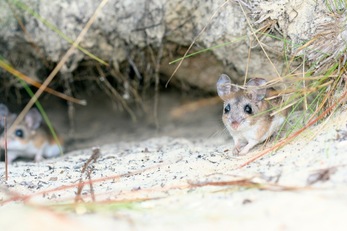 The Florida mouse (Podomys floridanus) is endemic to Florida and
is most commonly associated with sand-pine and coastal scrub, as well as
sandhill habitat that occur mostly on the geologic ridges throughout peninsular
Florida.
Left: Two Florida mice. Photo taken by James Austin
These are some of Florida’s most threatened habitats. This project was
initiated to determine whether genetic differences exist locally or regionally
among populations across the range of the Florida mouse. The conclusion of this
project resulted in the first comprehensive genetic assessment of the Florida
mouse, filling data gaps and providing information essential to management
recommendations, increasing the knowledge level for this species by 1-2 steps
and moving us toward achievement of the Action Plan’s Data Gaps Goal.
The findings of this study support the conclusion that
genetic differences within and between Florida mouse populations are closely
associated with major ridge and xeric (dry) habitats, reflecting limited, if
any, breeding between ridge systems. Within ridges, interactions between
breeding populations were likely common prior to modification of the scrub and
sandhill habitat mosaic (i.e. fragmentation and habitat conversion). Results from
the genetic analysis suggest that natural re-colonization of ridges by the
Florida mouse will be limited, thus as their populations go extinct, population
reestablishment is unlikely. Some clear
management implications from this study included careful consideration of
Florida mouse translocations between habitat types, and the importance of
habitat management particularly within areas where genetically isolated
populations likely persist in small numbers.
|
Long-term Monitoring to Determine Turtlegrass Recolonization Rates in Restored Vessel Injuries
Principal Investigator: Penny Hall, Florida Fish and Wildlife Conservation Commission
Restoring physical damage to seagrasses caused by
boat propellers, anchors or groundings was identified as a conservation action
in the 2012 State Wildlife Action Plan and the draft 2018 plan. Seagrass beds
support a variety of Species of Greatest Conservation Need, including manatees,
sea turtles, shorebirds (foraging grounds), and sharks, and provide ecological
services, including nutrient cycling and fisheries production. Groundings and
boat propellers can excavate grasses and sediment, resulting in blowholes
(depressions) or trenches, and restoration is often necessary to recover or
accelerate recovery of the seagrasses.
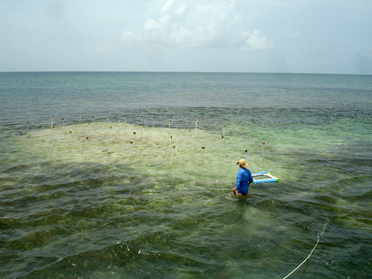
Left: Many seagrass beds show the crisscross scars of
vessels that have run aground and left holes empty of seagrass. Without the
dense mat created by seagrass roots, high wind and waves carry away the fine
sediment of the ocean floor, eroding and deepening the scars (also called
“blowholes” by researchers).
In 2008,
researchers received State Wildlife Grant funding to evaluate techniques to
restore severe boat damage to seagrass beds (Project ID 6330, FWC and NOAA).
The long-term goal being the recolonization of the slow-growing climax (or late
successional) species, turtlegrass (Thalassia
testudinum), which can take 5-10 years or more. In 2015, researchers
received a follow-up State Wildlife Grant to return to the restored sites to measure
if restoration success was achieved. Despite finding
successful re-grading and positive seagrass growth trajectories at 2-3 years
post-restoration, recruitment of turtlegrass was still incomplete 7 years
post-planting; of the 8 sites, only 3 were fully recovered with respect to Thalassia in October 2015. Long-term
monitoring (either continuous or sporadic) of restored sites is critical for
determining the effectiveness of restoration techniques, and the findings of
this project demonstrate the necessity for future monitoring at these sties to
determine the time required for turtlegrass to regain seagrass community
dominance.
|
Riverbank Restoration and Stabilization on the Chipola River (Baggett Farms Property)
Principal Investigators: Garry Warren, Florida Fish and Wildlife Conservation Commission and Jessica Graham, Southeastern Aquatic Resources Partnership

The Chipola river basin is ranked as a high priority preservation
basin in Florida’s 2012 State Wildlife Action Plan.
Right: Restored streambank at Baggett Farms
Preservation basins are
relatively pristine and stable systems with high value to wildlife. Maintaining
and improving these systems is essential to many of Florida’s species of
greatest conservation need (SGCN.) A stretch of the Chipola was identified as a
source of erosion which was degrading essential spawning habitat for shoal bass
and 5 SGCN mussel species. Florida’s Wildlife Legacy Initiative (FWLI) acted in
partnership with USFWS, SARP, and Mr. Baggett, a private landowner, to protect
and restore 2.3 miles of stream bank. Fencing was installed along 2.3 miles of
riverbank to keep cattle out of the river and wells were installed to provide
an alternative water source. A particularly degraded section of approximately
200 linear feet was graded, hardened, and planted. With the combination of
selective active restoration, and the exclusion of cattle from the stream,
vegetation was able to return to the system. The vegetated shoreline is less
prone to erosion, and the presence of canopy coverage shades the river making
it more desirable for shoal bass.
This project was a model and inspiration for
additional projects between state, federal, and local entities collaborating
with private landowners to restore and conserve aquatic habitats. A video with
additional information on this and related projects is available on YouTube.
|
Coastal Habitat Integrated Mapping and Monitoring Program (CHIMMP)
Principal Investigators: Ryan Moyer and Kara Radabaugh, Florida Fish and Wildlife Conservation Commission
Florida’s salt marshes and mangroves are critical coastal habitats that provide shoreline stabilization, filtration of surface water, and are nursery habitats for numerous ecologically and economically important species of fish and crustaceans, including over 100 Species of Greatest Conservation Need. However, these important habitats are vulnerable to habitat loss, alterations to surface water hydrology, climate change, sea-level rise, and invasive species.
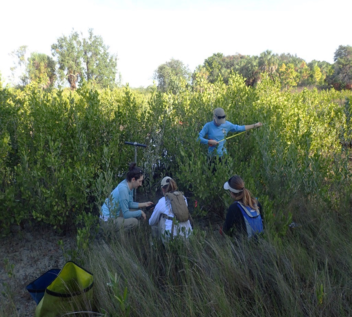
Left: FWC biologists conducting vegetation monitoring in Clam Bayou in Gulfport, FL.
The Coastal Habitat Integrated Mapping and Monitoring
Program (CHIMMP) was established in 2013 to facilitate the integration of salt
marsh and mangrove mapping and monitoring programs across Florida, as well as
address the Species and Habitat Monitoring Objective of the State Wildlife
Action Plan Monitoring and Adaptation Goal (2012-2018). The program was
designed to build on the successes of the Seagrass
Independent Mapping and Monitoring (SIMM) program, which coordinated the
integration of seagrass mapping and monitoring in Florida. Three workshops were
held to identify research and monitoring programs, leverage any duplicate
efforts, and identify data gaps and needs in coastal wetland mapping and
monitoring. The program produced a statewide
technical report describing the unique ecosystems, threats, management
priorities, and mapping and monitoring programs for 12 regions. Nearly 50
collaborators contributed to the writing and editing of this report.
Additionally, the program conducted monitoring pilot studies, including a side-by-side
comparison of common monitoring techniques that highlighted the rapid
succession of restored salt marsh habitats to mangrove-dominated ecosystems.
The mapping pilot studies created species-specific mangrove maps in the Tampa
Bay and automated, high-resolution maps of forested wetlands in Tampa Bay with
the use of a supercomputer and a novel processing method, reducing the
processing time from four to five months using traditional methods to under 24
hours.
|
The Population Genetic Structure of Dendrogyra cylindrus and Associated Symbiodinium
Principal Investigator: Iliana Baums, Penn State University
 This project investigated the genetics of Pillar
Corals in Florida and the genetics of their symbiotic zooxanthellae to
contribute to the 2012-2018 Marine Implementation Goal: “To improve coral reef
restoration and conserve SGCN through planning and research.”
Right: Pillar coral
Pillar Coral is
very rare and declining in Florida and will require restoration outplantings to
ensure the persistence of this species in our waters. Restoration practitioners normally try to
increase the survivorship of corals that they outplant by using corals that are
genetically similar to those in the area, if genetic differences exist between
populations. Differences in the organism’s genetics may be caused by
adaptations to local conditions, so using corals adapted to the local area increases
the chances of restoration success. This project found that there were no
significant differences between Pillar Corals throughout their range in
Florida, but that Florida Pillar Corals did differ from those in Curacao.
Because corals harbor symbiotic zooxanthellae, the genetic composition of these
symbiotic organisms also can impact restoration success. Two different variants
of Pillar Coral zooxanthellae were found in samples from Florida but were not
associated with location or water depth. These two variants may be adaptive to
other smaller scale environmental conditions, which would require study to
determine. Based on the contributions of this study, Pillar Corals can be
transplanted to any location in Florida from any other location in Florida without
concern about mixing population genetics or impacting the chances of
restoration success.
|
|